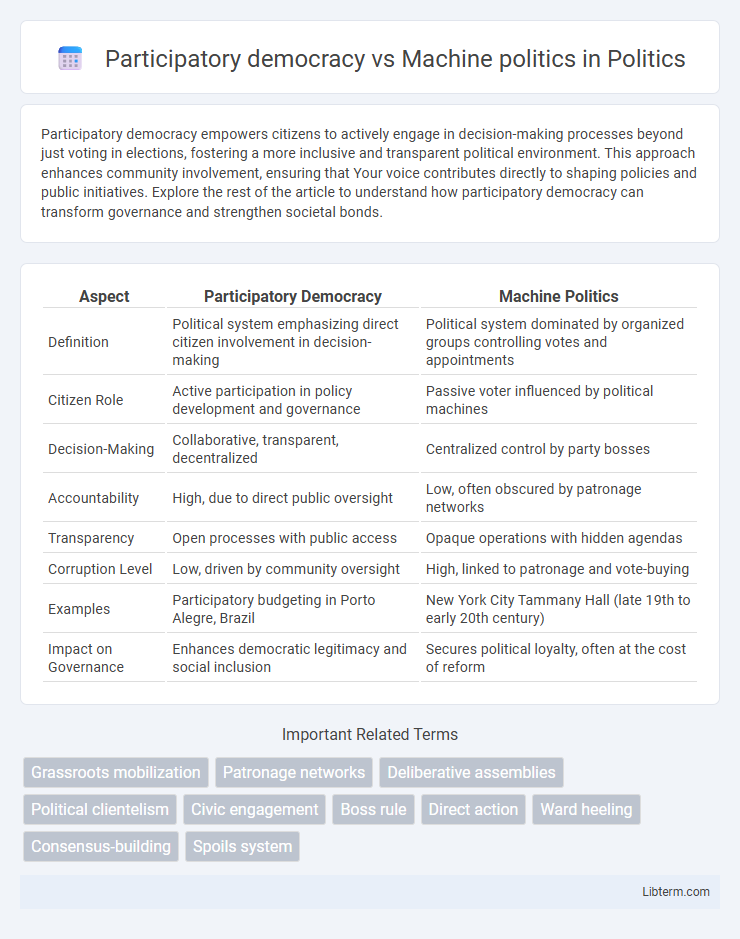Participatory democracy empowers citizens to actively engage in decision-making processes beyond just voting in elections, fostering a more inclusive and transparent political environment. This approach enhances community involvement, ensuring that Your voice contributes directly to shaping policies and public initiatives. Explore the rest of the article to understand how participatory democracy can transform governance and strengthen societal bonds.
Table of Comparison
| Aspect | Participatory Democracy | Machine Politics |
|---|---|---|
| Definition | Political system emphasizing direct citizen involvement in decision-making | Political system dominated by organized groups controlling votes and appointments |
| Citizen Role | Active participation in policy development and governance | Passive voter influenced by political machines |
| Decision-Making | Collaborative, transparent, decentralized | Centralized control by party bosses |
| Accountability | High, due to direct public oversight | Low, often obscured by patronage networks |
| Transparency | Open processes with public access | Opaque operations with hidden agendas |
| Corruption Level | Low, driven by community oversight | High, linked to patronage and vote-buying |
| Examples | Participatory budgeting in Porto Alegre, Brazil | New York City Tammany Hall (late 19th to early 20th century) |
| Impact on Governance | Enhances democratic legitimacy and social inclusion | Secures political loyalty, often at the cost of reform |
Understanding Participatory Democracy
Participatory democracy emphasizes direct citizen involvement in decision-making processes, contrasting sharply with machine politics where power is concentrated in party organizations or political bosses controlling votes through patronage. Understanding participatory democracy involves recognizing its goal of empowering individuals to actively engage in governance, promoting transparency, accountability, and equitable representation. This model fosters civic responsibility and enhances policy outcomes by integrating diverse perspectives and community needs directly into political deliberations.
Defining Machine Politics
Machine politics refers to a political system dominated by organized groups, often called political machines, that rely on patronage, loyalty, and centralized control to maintain power and influence. These entities manipulate electoral processes and public resources to secure votes and reinforce their authority. Unlike participatory democracy, which emphasizes active citizen involvement and decentralized decision-making, machine politics prioritizes hierarchical organization and strategic control over grassroots engagement.
Historical Origins and Evolution
Participatory democracy emerged prominently during the early 20th century as a response to limited citizen involvement in political decision-making, emphasizing direct public engagement in governance processes. Machine politics traces its roots to the mid-19th century urban centers, where political organizations manipulated immigrant and working-class voters through patronage and hierarchical control to maintain power. Over time, participatory democracy evolved to incorporate grassroots movements and digital platforms, while machine politics declined due to reform efforts and the rise of professionalized political parties.
Core Principles and Values Compared
Participatory democracy emphasizes direct citizen involvement, transparency, and equal representation, fostering a political culture centered on collective decision-making and community empowerment. Machine politics relies on hierarchical party organizations, centralized control, and patronage systems, prioritizing efficiency, loyalty, and the consolidation of political power. Core values in participatory democracy are inclusivity and civic engagement, whereas machine politics stresses strategic coordination and political stability through controlled mobilization.
Citizen Engagement and Political Participation
Participatory democracy emphasizes active citizen engagement through direct involvement in decision-making processes, fostering greater political participation and community empowerment. Machine politics relies on established political organizations controlling votes and mobilizing supporters through patronage networks, often limiting genuine civic involvement. Enhanced citizen engagement in participatory democracy leads to more transparent governance and accountable leadership compared to the top-down approach seen in machine politics.
Decision-Making Processes and Transparency
Participatory democracy emphasizes inclusive decision-making processes where citizens actively engage in discussions, ensuring transparency through open forums and accessible information. Machine politics relies on hierarchical structures and controlled communication channels, often resulting in opaque decision-making dominated by political machines. The transparency gap in machine politics contrasts sharply with the participatory model's focus on accountability and public input.
Impacts on Representation and Accountability
Participatory democracy enhances representation by actively involving citizens in decision-making processes, fostering diverse viewpoints and stronger community engagement. Machine politics often centralizes power within party elites or political machines, which can diminish individual voter influence and reduce accountability through patronage and backroom deals. Consequently, participatory democracy promotes transparency and responsiveness, while machine politics risks entrenching corruption and weakening democratic accountability.
Case Studies: Successes and Failures
Participatory democracy in Porto Alegre, Brazil, showcased success through its participatory budgeting process that increased citizen engagement and improved public resource allocation. Conversely, Chicago's machine politics highlighted failures with entrenched corruption and limited public input, undermining democratic accountability. Case studies reveal that participatory models enhance transparency and inclusivity, while machine politics often perpetuate clientelism and political monopolies.
Challenges Facing Each System Today
Participatory democracy faces challenges such as voter apathy, unequal access to political education, and the risk of popular decisions overshadowing expert knowledge, which can hinder effective governance. Machine politics struggles with entrenched corruption, patronage networks, and lack of transparency, leading to diminished public trust and exclusion of marginalized voices. Both systems require innovative reforms to enhance accountability, inclusivity, and citizen engagement in contemporary political landscapes.
Future Prospects and Hybrid Approaches
Future prospects for participatory democracy emphasize increased citizen engagement through digital platforms, enhancing transparency and accountability in governance. Machine politics, often characterized by centralized control and algorithm-driven decision-making, may benefit from integrating human judgment to address ethical concerns and biases. Hybrid approaches combining AI technologies with citizen participation promise more inclusive, efficient, and adaptive political systems that leverage both algorithmic precision and grassroots input.
Participatory democracy Infographic

 libterm.com
libterm.com